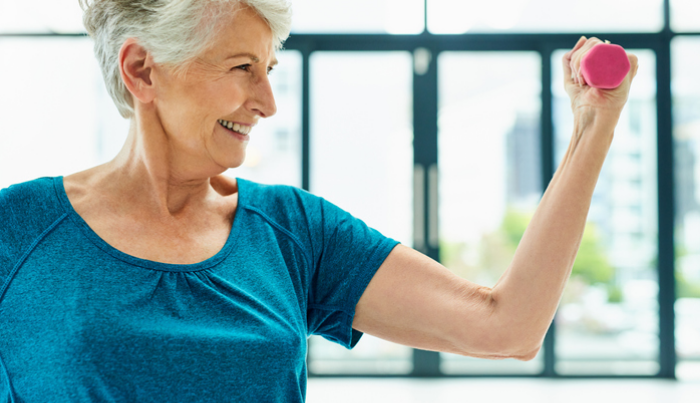Loss of bone mass is a common occurrence of aging. Around the age of 40, the body starts to lose bone density and the risk of developing osteoporosis increases. Osteoporosis occurs when enough bone mass has been lost, that the bones become fragile and can be easily fractured from falls or even minor bumps.
Bones are often seen as merely a structural necessity, but they are important for numerous functions in the body, including:
-Protection of vital organs
-Production of blood cells
-Storage of important minerals
-Storage of energy sources
As we age, loss of bone mass not only increases the risk of fractures, it affects the bones’ ability to properly carry out their functions. It is estimated that, worldwide, one in three women and one in five men over the age of 50 will break a bone due to osteoporosis.
But osteoporosis does not have to be a burden of aging. There are steps people can take to slow the rate of bone loss, maintain healthy bones, and prevent osteoporosis.
Eat a Well-Balanced Diet Rich in Whole Foods
Eating a varied and well-balanced diet is a critical step in the prevention and management of osteoporosis. A diet rich in nutrients, vitamins, and minerals helps the body perform all of its functions properly, including bone formation.
Calcium and vitamin D are two of the most important nutrients in maintaining bone health. Ninety-nine percent of the calcium in the body is found in the bones, while vitamin D helps the body to absorb calcium. Calcium is found in dairy products, leafy greens, legumes, and dried fruit while vitamin D can be found in foods like mushrooms and fish. However, many people choose to get their daily intake of calcium and vitamin D from supplements.
Protein is a nutrient that preserves bone mass. It is found in animal sources like fish and dairy products. Protein can also be consumed from plant sources like lentils, grains, and nuts.
Nutrients found in plants have been shown to support bone density in both men and women. Fruits, vegetables, and grains provide the body with a wide range of vitamins, minerals, and
micronutrients that are necessary for bone tissue renewal, including vitamin A, vitamin B, vitamin K, magnesium, and zinc.
Do Daily Weight-bearing Exercises
Like muscles, bones also become stronger when exercised correctly. Weight-bearing and resistance exercises are the best types of activities for strengthening the bones. Exercise also helps to strengthen the muscles and maintain or improve coordination and balance, which can help prevent falls and broken bones.
Examples of weight-bearing exercises include walking, climbing stairs, and dancing. Examples of resistance exercises include push-ups, squats, and lifting weights. Exercises like running and jumping are not necessary and may put added stress on already fragile bones.
Quit Smoking and Limit Alcohol Consumption
Researchers have found that drinking alcohol, smoking tobacco, and taking certain medications could increase the risk of developing osteoporosis. These lifestyle factors or modifiable factors can interfere with the normal function of mitochondria (a cellular structure that produces energy for the body). When mitochondrial function is compromised, it sends out a stress signal.
When this occurs in cells called macrophages (a type of immune cell that detect, consume, and digest foreign substances in the body, like pathogens), they turn into osteoclasts (a type of cell that absorbs bone tissue). This stress response can lead to an overproduction of osteoclasts and therefore an acceleration of bone loss.
Consider Bone-Forming Medications
In some cases, metabolic conditions can affect the rate at which a person’s body loses bone density. For these individuals, or for people who have advanced bone density loss, doctors may recommend bone-forming medications.
Hormone therapy may also be a viable treatment option for both men and women. As men age, testosterone levels drop and may contribute to osteoporosis. Women are more susceptible to bone loss after menopause due to a sudden drop in estrogen.
Sources:
https://orthoinfo.aaos.org/en/staying-healthy/healthy-bones-at-every-age/
https://www.iofbonehealth.org/facts-statistics
https://www.webmd.com/osteoporosis/features/diet-dangers
https://www.bones.nih.gov/health-info/bone/bone-health/exercise/exercise-your-bone-health
https://www.ncbi.nlm.nih.gov/pmc/articles/PMC2991386/
https://www.medicalnewstoday.com/articles/325163.php#1
https://www.healthline.com/health/bone-health/bone-function#function
https://www.iofbonehealth.org/nutrition
https://www.mayoclinic.org/diseases-conditions/osteoporosis/diagnosis-treatment/drc-20351974
https://www.bones.nih.gov/health-info/bone/osteoporosis/men
https://www.healthline.com/nutrition/how-to-increase-vitamin-d



